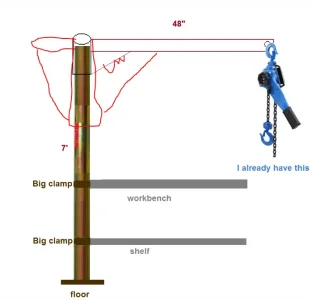slow-poke
Ultra Member
Being the ever thrifty but suddenly in need of a mini workbench crane kind of guy, I conjured up the following image of the ~$100 DIY version of the TelePro.
I already have a lever chain lift, so just need to get two pipes for the mast (7' and 1'), the lateral beam and two clamps.
Question is:
0) Is this a really bad idea? assuming not.....
1) How small can I go with the mast; diameter and wall thickness? Found a telepost on marketplace, I think that should be adequate?
2) For the lateral beam, round or some sort of mini I-Beam?, and suitable (minimal) size? I suppose I could get two teleposts and use one for the lateral beam?
 www.facebook.com
www.facebook.com
I can weld.

I already have a lever chain lift, so just need to get two pipes for the mast (7' and 1'), the lateral beam and two clamps.
Question is:
0) Is this a really bad idea? assuming not.....
1) How small can I go with the mast; diameter and wall thickness? Found a telepost on marketplace, I think that should be adequate?
2) For the lateral beam, round or some sort of mini I-Beam?, and suitable (minimal) size? I suppose I could get two teleposts and use one for the lateral beam?
Log into Facebook
Log into Facebook to start sharing and connecting with your friends, family, and people you know.
 www.facebook.com
www.facebook.com
I can weld.
Last edited:

